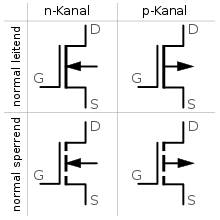MOSFET
A metal-oxide-semiconductor field-effect transistor (MOSFET, also MOS-FET, rarely MOST) is a type of transistor belonging to the insulated gate field-effect transistors (IGFET). In their original and still often used form, they are defined by a layer stack consisting of a metallic gate electrode, a semiconductor and the oxide dielectric in between. This represents a metal-insulator-semiconductor structure, which is why one can also speak in general terms of metal-insulator-semiconductor field-effect transistors (MISFET), which also include variants with non-oxide dielectrics. In the course of technical development, the metallic gate of MOSFETs with silicon as the semiconductor material was replaced by doped polysilicon. For this variant, the designation MOSFET was largely retained, see also section Name.
As with all IGFETs, the current flow in the semiconductor area between the two electrical terminals drain and source is controlled via a control voltage (gate-source voltage) or control potential (gate potential) at a third terminal, the so-called gate. Unlike junction field effect transistors, this is electrically insulated from the semiconductor (and thus from the drain and source) by a dielectric.
Due to manufacturing advantages over other variants, MOSFETs with silicon as the semiconductor material have become the most widely used transistor type for analog and digital integrated circuits since the 1970s. Here they are used, among other things, as part of logic gates in digital circuits. The development in this field is known for the steady scaling of transistors. Here, it has been possible to increase the packing density for this type of transistor by orders of magnitude and to keep manufacturing costs low through mass production, so that in 2008, for example, up to 1.9 billion transistors were installed in a single processor. By using new variants, such as FinFETs, the scaling could be continued. Thus, in 7 nm technology, it is possible to install over 54 billion transistors in a processor (Nvidia GA100 Ampere).
Also in other applications, such as switching of high currents or with high voltages (cf. power transistor), silicon MOSFETs are represented or even standard in many areas, other materials are gallium arsenide or also organic semiconductors. Increasingly, however, the physical limits of silicon are being exhausted, and for special applications other semiconductor materials with better properties than silicon for this application are of interest today, such as compound semiconductors or semiconductors with larger band gaps, such as silicon carbide (SiC) and gallium nitride (GaN), even if the production costs are still considerably higher at present.

Circuit symbols of the basic MOSFET types
History
The functional principle of MOSFETs is about 20 years older than that of the bipolar transistor. The first patent applications date back to 1926 by Julius Edgar Lilienfeld and 1934 by Oskar Heil. However, the first MOSFETs were not manufactured until 1960, when silicon/silicon dioxide became available as a material system with which a reproducibly good semiconductor-insulator interface could be produced. This was associated with a move away from germanium as the base material and increasing demands on the manufacturing conditions (clean rooms, strict temperature regime).
From the beginning or middle of 1970, doped polysilicon was used as a gate material, replacing evaporated aluminium. Since the turn of the millennium, there has been increased research into the new high-k+metal gate technology, which was used in mass production for the first time in 2007.
Name
The name metal-oxide semiconductor field-effect transistor derives from the original layer sequence of the gate layer stack. Until the early 1980s, the use of aluminum (a metal) as the gate material dominated, separated from the conductive channel in the silicon substrate (semiconductor) by a non-conductive silicon dioxide layer (insulator). In the 1980s, processes using doped polysilicon as the gate material became increasingly common. This is still the most common design of commercially available CMOS circuits. Since no metal is used, the designation MOSFET is no longer correct, but is still used as a synonym.
With increasing miniaturization, MOS transistors with polysilicon gate show electrical disadvantages, because a depletion region forms in the gate with certain circuits (polysilicon depletion). Therefore, research into alternative gate materials (e.g. transition metals) has been carried out since the early 2000s. In parallel, research was also conducted into alternative insulator materials with high dielectric constant (so-called high-k materials) in order to reduce the increasing leakage currents. In 2007, Intel was the first manufacturer to introduce the combination of both changes (cf. high-k+metal gate technology); several other manufacturers of high-performance processors followed. In these cases the designation MOSFET is therefore correct again, nevertheless it is often more convenient to use the neutral designation MISFET (metal-non-conductor-semiconductor FET) or more generally IGFET (FET with insulated gate).
Questions and Answers
Q: What is a MOSFET?
A: A MOSFET is a metal-oxide-semiconductor field-effect transistor, which is an electronic component that acts as an electrically controlled switch.
Q: What are transistors used for?
A: Transistors are small electrical devices that are used in radios, calculators, and computers; they are some of the most basic building blocks of modern electronic systems.
Q: How does a MOSFET work?
A: A MOSFET acts like a valve for electricity. It has one input connection (the "gate") which is used to control the flow of electricity between two other connections (the "source" and "drain"). The gate acts as a switch that controls the two outputs.
Q: What does the name 'MOSFET' refer to?
A: The name MOSFET describes the structure and function of the transistor. 'MOS' refers to the fact that it is built by layering metal (the "gate") on oxide (an insulator which prevents the flow of electricity) on semiconductor (the "source" and "drain"). 'FET' describes the action of the gate on the semiconductor.
Q: Where are almost all MOSFETS used?
A: Almost all MOSFETS are used in integrated circuits.
Q: How many transistors can be fit onto an integrated circuit today compared to 1970?
A: As of 2008, it is possible to fit 2,000,000,000 transistors on a single integrated circuit whereas in 1970 around 2,000 could be fitted onto one IC.
Search within the encyclopedia